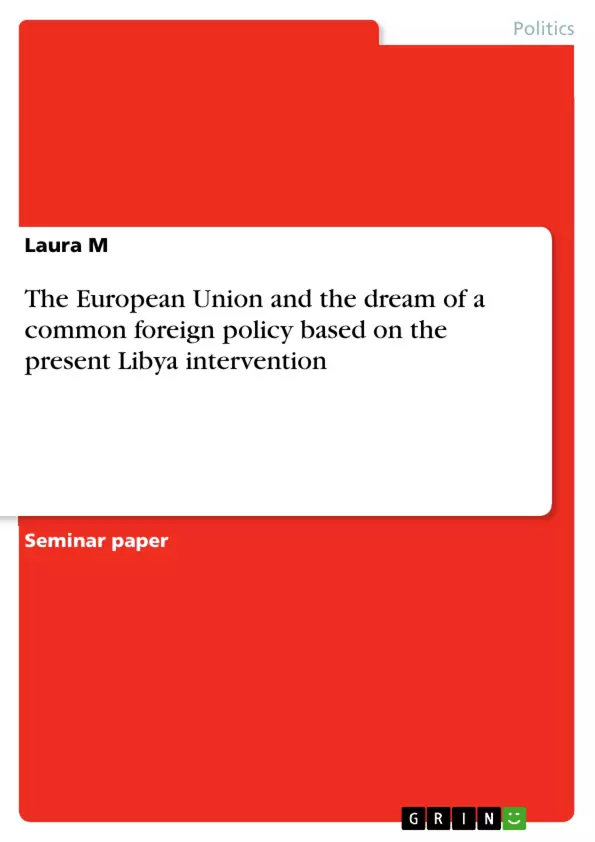1. Introduction
If the European Union wants to be a serious actor on world stage they need more strategic thoughts and above all the real and permanent will of the Member States acting together. The national states are too small for the challenges of our epoch. How to save the climate, guarantee security or offer economic prosperity, if all these topics are interweaved within the international system?
Moreover a new constellation in the international policy becomes obvious. The unipolar moment of the USA is over. With the rise of China and India the multipolar world will be more and more important. Therefore a new balance has to be created by those states.
The European Union has no choice: It has to take up these challenges but it has also the potential to develop the rules of the new world order. The EU makes 35 percent of the world production and the world’s biggest exporter of goods.1 Its population is with more than 500 million inhabitants bigger than the population of Russia and USA together.
The lack of the common foreign policy is so serious because European Union is liable to break down as an actor in the world policy. Its political and economic interests reach clearly over its territory. Moreover the European Union is affected directly from crisis or conflicts concerning raw material supply or energy supply.
Relating to security policy the European Union is currently threatened by really different groups (from Al-Qaida to Somali pirates). Because of those problems the EU has to be incomprehensible as a global actor.
Just because working together in the foreign policy is so important this paper has the goal to find out whether the Member States of the EU are able to cooperate concerning current crisis in Libya. Therefore follows at first a short historical overview about the historian steps to come closer to a common foreign policy in the EU. Then there is a short summary about the intervention of Libya. After that you have to analyze the behavior of the most influential Member States (France, Great Britain and Germany) because if they have common position in the field of foreign policy it is more easier for the EU to reach a common point of view for all Members. Last but not least you have to come to a conclusion whether a European Union common foreign policy exist or not.
Inhaltsverzeichnis (Table of Contents)
- Introduction
- Historical overview
- The Treaty of Maastricht
- The Treaty of Amsterdam
- The Treaty of Lisbon
- The intervention in Libya
- The behavior of the most important members of the EU in the Libya crisis
- France - Engaged endeavors in Libya
- Great Britain - France's Best friend
- Germany - The skeptics
- A dream still remains a dream
Zielsetzung und Themenschwerpunkte (Objectives and Key Themes)
This paper aims to analyze the ability of European Union Member States to cooperate in addressing the current crisis in Libya, focusing on whether they can achieve a unified foreign policy stance. The paper examines the historical development of the EU's foreign policy framework, the intervention in Libya, and the behavior of key Member States, particularly France, Great Britain, and Germany. The key themes explored include:- The challenges of creating a unified foreign policy for the European Union
- The historical development of the EU's foreign policy framework
- The role of the EU in the Libyan crisis
- The positions and actions of key Member States in the Libyan intervention
- The impact of national interests and sovereignty on EU foreign policy
Zusammenfassung der Kapitel (Chapter Summaries)
- Introduction: This chapter sets the stage by highlighting the need for a unified European foreign policy in a multipolar world and emphasizing the challenges posed by global issues such as climate change, security, and economic prosperity. The chapter also discusses the importance of the EU's position as a global actor and the potential consequences of failing to develop a common foreign policy.
- Historical Overview: This section provides a historical overview of the European Union's efforts to develop a common foreign policy, focusing on key milestones such as the European Economic Community (EEC), the failed attempts to create a European Defence Community and the Fouchet Plan, and the establishment of the European Political Cooperation (EPC). The chapter also discusses the impact of the collapse of the Soviet Union, the Yugoslav Wars, and the reunification of Germany on the development of the EU's foreign policy framework.
- The Treaty of Maastricht: This chapter examines the Treaty of Maastricht, also known as the Treaty on European Union (TEU), which consolidated the EU's commitment to a common foreign policy. It analyzes the different perspectives and challenges faced during the negotiations, including the contrasting views of Germany and France on institution-building and the role of national sovereignty. The chapter also discusses the establishment of the Common Foreign and Security Policy (CFSP) and its key features.
Schlüsselwörter (Keywords)
This work focuses on the European Union's foreign policy, examining the historical development of its framework and analyzing the challenges of achieving a unified stance, particularly in the context of the Libyan intervention. The key terms and concepts explored include: common foreign policy, European Union, Member States, Libya crisis, France, Great Britain, Germany, national sovereignty, international system, multipolar world, and CFSP.- Arbeit zitieren
- Laura M (Autor:in), 2011, The European Union and the dream of a common foreign policy based on the present Libya intervention, München, GRIN Verlag, https://www.grin.com/document/190551



